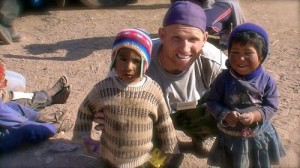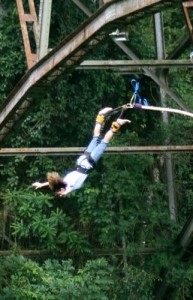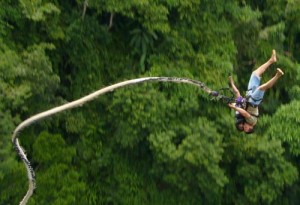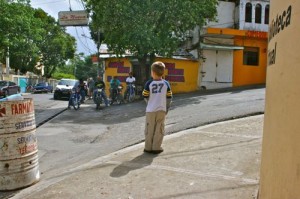
Kayaking in Bocas del Torro, Panama
In Part 1 of this series, I discussed how Family Travel Builds Confidence through Language and Social Interaction.
This is Part 2, which discusses how confidence and character are built through travel by 1) trying new things and 2) being uncomfortable.
Trying New Things
What is the purpose of travel except to see, hear, taste, smell and try new things?
Isn’t that why we do it?
If everything was exactly the same in the place we visited, there would be no point in going.
But we go because we want to try the beach, taste the seafood, see the ruins, smell the fresh air, hear the waves and experience for ourselves what we’ve only heard or read about from others.
 And as we try new things, an amazing thing happens. In that very act -
And as we try new things, an amazing thing happens. In that very act -
while climbing the steps of ancient ruins;
taking that bite of our first mango;
attempting surfing for the very first time;
moving our feet to the rhythm of an unfamiliar beat;
or inhaling the aura of a primary rain forest
- in that moment something happens to us.
The experience becomes a part of who we are, and we become a different person, as though we’re instilled with a sense of ‘knowing’ - the knowing that comes only from having tried something yourself, instead of having heard about it from others.
We seem to stand taller, walk more confidently and feel more at home in the world and more at peace with ourselves.
The wonderful thing is that we can help our children to develop (or better yet, maintain, since small children already possess it) this capacity from the beginning.
We can help them to look around at the world, and feel comfortable and capable - self-assured in their ability to take on new challenges, handle change and unexpected disappointments, and to stand tall as a leader in their generation.
Can the act of ‘trying new things’ really be so powerful?
 It was another perfect day in the Central Valley of Costa Rica, our home for the past several months.
It was another perfect day in the Central Valley of Costa Rica, our home for the past several months.
A group of expat and tourist friends decided they were going bungee jumping, and we agreed to join them.
Determined to be brave (and to get it over with), I volunteered to go first.
Attempting to avoid the butterflies in my stomach, I envisioned what I would do in just a few moments.
Stand. Walk. Step. Fly.
Simple.
Except for the last part. Instead of flying, I fell - like a rock - for 242 feet, until the bungee cord jerked me like a fish on a line.
My body in convulsions, I dangle upside down wondering what I just did to myself.
Soon I’m hoisted back to the bridge where moments ago I’d taken that fatal step. The five year old child of a friend comments, “I thought you were dead.” So did I.
My husband is next, and he attacks with his usual gusto.
Hesitantly, one by one our friends follow suit. Then our daughter Kyah, having watched both parents take the plunge, announces her intentions to try.
In my mind I’m remembering what I just went through, and I’m sorely tempted to talk her out of the endeavor.
But then recalling that I’m trying to raise children who are confident and not afraid to try new things, I bite my tongue instead.
Strapped tandem to a guide, I watch her from the bridge, video camera in hand.
A crowd has gathered to watch this gutsy little girl, and a man next to me declares, “That little girl’s got more ______ than I do. She can’t be more than 10.”
 “She’s four,” I announce.
“She’s four,” I announce.
“FOUR!!????!!!!”
The next moment she’s flipping through the air, minus any girly screams of fright.
Before long they’re pulled back up to the bridge, where the awed onlookers spontaneously erupt into applause.
A grin the size of Texas steals across her face as I nearly burst into tears with pride.
I watched her confidence grow ten sizes, and to this day she still has bragging rights - and rightfully so.
(Watch the video of her jump.)
Try it for yourself. Not necessarily bungee jumping, but doing something new.
You don’t have to master it, just attempt it, especially if you feel a slight hesitation at doing so.
Get on a horse, order something different at a restaurant, say hello to a stranger or read an unfamiliar genre.
See how you feel at having just made the endeavor.
Then once you’re comfortable trying new things at home (or even before you are), go to a different country, where even the familiar becomes foreign (like say, grocery shopping or using the toilet).
Being Uncomfortable
Speaking of using the toilet in different countries brings us to the topic of being uncomfortable.
Being uncomfortable often goes hand-in-hand with trying new things, because it’s usually the restraint that holds us back.
Why is being uncomfortable important, or a tool for building confidence?
Simple. Discomfort means that we’ve left our comfort zone. And it’s outside of our comfort zone where true personal growth occurs.

Feeling uncertain can make you stronger
You know your comfort zone - that cozy, warm, fuzzy place where everything is just how you like it.
The temperature is controlled, your routine is predictable, grocery shopping is down to a science, bedtime is set, meals are unsurprising, and your favorite shows come on the same time each week.
And while this is a pleasant and inviting existence, what developments are taking place? What personal improvements are being made?
Don’t misunderstand, growth is occurring, but on a nano scale compared to the potential that lies just beneath the surface.
Because although ten years may pass in this comfy way, it’s really as though one year has been repeated ten times, instead of having ten years of different experience.
Anthony Robbins once took a year and had as many different experiences as he could - sky diving, bungee jumping, rock climbing, jet flying.
He said that he had more experiences in one year than most people have in ten - and he grew so much that it was incomprehensible.
It makes sense, don't you think?
If you look at the image of the tree rings below, you’ll see that these trees are the same age - 50 years old.

Yet one tree is more than double the size of the other. Why?
Well, it says that the larger cross-section came from a ‘dominant’ tree - it grew in an area where it had plenty of sunshine.
The smaller tree grew in the shade of larger trees, thus receiving less nutrition and experiencing less growth.
When I think of Anthony Robbins and others like him, I think of a ‘dominant’ tree, someone who ‘takes life by the horns’ and lives everyday of his life.
As a result, he experiences tremendous personal growth and becomes a ‘giant’ of a man.
But too many of us live our lives in the shadow of these ‘dominant’ trees - watching their lives through a box on the wall, but never stepping out into the sunshine to try it for ourselves.
And what is it that stops us? Generally our avoidance of any discomfort - whether it comes in the form of fear, uncertainty, aversion or any other emotion that makes us, well, uncomfortable.
Travel provides a natural and nearly limitless opportunity to ‘get uncomfortable’ through trying new things.
Visit a different country and you’ll be doing ‘new things’ with everything you do - eating, sleeping, using the bathroom, speaking, shopping.
And while at first it may seem ‘uncomfortable’, you’ll soon discover that you’ve grown accustomed to it, your self-confidence has increased, and you feel ready to take on even bigger challenges.
When my son Parker was five years old we moved to the Dominican Republic.

Language doesn't stop friendship
As we exited the plane and walked out into the noisy, confusing and all-together unfamiliar airport terminal, I saw a little boy uncertain and a little bit frightened, as he turned and looked up at me and asked, “Are they speaking Spanish?”
Feeling somewhat discomforted myself, my heart felt saddened at his uneasiness.
Yet I knew that it was ‘good for him’ (as well as for me), and the best thing to do was to ‘set a good example’ of mustering courage in the midst of fear and uncertainty.
Six months later, as we prepared to leave our Caribbean home, this same little boy was confidently conversing in Spanish with his Dominican friends who had taught him how to eat a mango, find ‘manzana coco’, jump rope and climb coconut trees.
He had developed confidence, and the original temporary discomfort had been worth it.
How has travel helped you to try new things or get uncomfortable?
Comments
Powered by New Facebook Comments

I really like the tree example. Its amazing that the two trees are actually the same age but completely different sizes. More experiences allow for much larger growth.
So true!